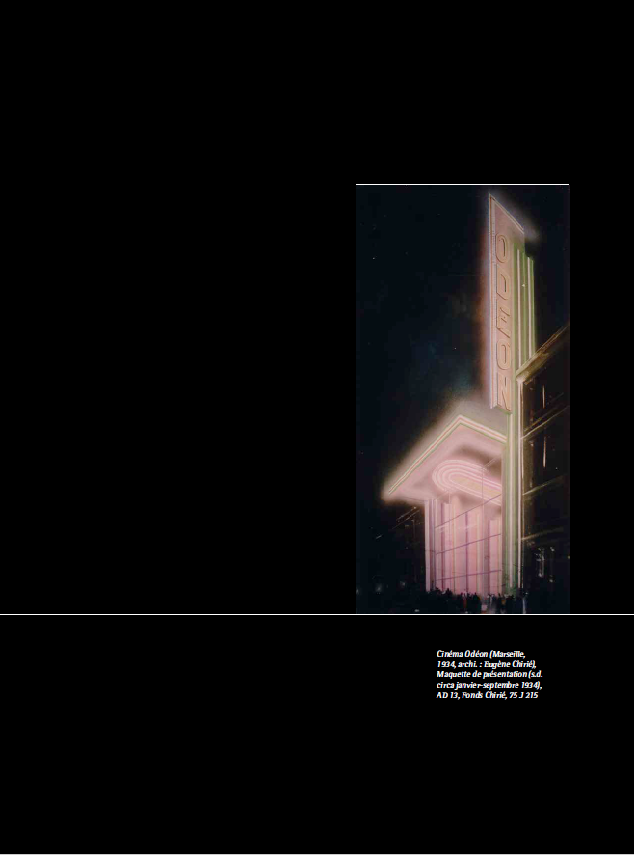Resumen
A principios de la década de 1920, la arquitectura cinematográfica se encontraba aun en sus primeros días. Al tiempo que, un grupo de arquitectos (Henri Sauvage, Marcel Oudin, Eugène Vergnes, Charles Siclis, Auguste Bluysen) y de propietarios ansían el nacimiento de una arquitectura específica que se adaptara a la proyección, y liberada de toda relación con la herencia de la arquitectura teatral; el eclecticismo –o en ocasiones el arcaísmo- de las soluciones implementadas, fueron el testimonio de la efervescencia que caracterizó aquellos años de investigación en torno a dicha arquitectura. En Francia, sólo tras la promoción comercial de las películas sonoras y su progresiva generalización durante los años 1930, se propició un segundo nacimiento del cine. Los directores de salas de cine dirigieron una extraordinaria campaña de sonorización y modernización de los establecimientos destinados a la exhibición cinematográfica. Aprovechando la oportunidad surgida para inventar una arquitectura que pudiera satisfacer plenamente las exigencias del espectáculo y de aquello que lo rodeaba, los arquitectos asimilaron y experimentaron de esta forma, el concepto mismo de la modernidad.
Abadie, S. (2012). Une histoire architecturale de cinémas, genèse et métamorphoses de l’architecture cinématographique à Paris (1907-1939). Thèse de doctorat, Strasbourg: Université de Strasbourg.
Bosséno, C.-M. (1996). La prochaine séance. Les Français et leurs cinés. Paris: Gallimard, collection Découvertes Gallimard.
Buxtorf, A.-E. (2005). La salle de cinéma à Paris entre les deux guerres. L’utopie à l’épreuve de la modernité. Bibliothèque de l’Ecole des chartes, 163, 117-144.
Cinqualbre, O. (2005). L’architecture en studio. In: Robert Mallet-Stevens. L’oeuvre complète, [catalogue d’exposition du Centre Pompidou] Paris.
Goissaud, A. (1933). Le Rex. Cinéma-théâtre à Paris. La Construction moderne, 48(16), 238-247.
Jeancolas, J.-P. (1983). Quinze ans d’années trente : le cinéma des Français 1929-1944, Paris: Stock.
Lacloche, F. (1981). Architecture de cinémas. Paris: Le Moniteur.
Louis, M. (1980). Mallet-Stevens et le cinéma. In: Culot, M., Deshoulières, D. et H. Jean¬neau (éd.), Robert Mallet-Stevens, architecte, Bruxelles, AAM - Archives d’Architecture Moderne, p. 123-142.
Mallet-Stevens, R. (1924). Les cinémas. In: L’Art dans le cinéma français [brochure d’exposition du Musée Galliera] Paris.
Meusy, Jean-Jacques. 1997. Cinéac, un concept, une architecture . Cahiers de la cinémathè¬que française, (66), 91-121.
Marantz, É. (2006). Eugène Chirié (1902-1984). Une expérience de l’architecture au XXe siècle, (Thèse de doctorat d’histoire de l’art), Aix-en-Provence, Université de Provence.
Meusy, J.-J. (1995/2002). Paris-Palaces ou le temps des cinémas (1894-1918), Paris: CNRS Éditions.
Ragot, G. (2000). Architecture du XXe siècle en Poitou-Charentes. Prahecq: Editions Patri¬moines et Médias.
Roux-Spitz, M. (1932/1994). Contre le nouveau formalisme. Paris: Altamira.
Thevenon, L. (2002). « Léonard Varthaliti », Dictionnaire historique et biographique du comté de Nice. Nice: Serre Editeur.
Vergnes, E. (1921). Cinéma. La Construction mo¬derne, 37, 97-98.
Vergnes, E. (1923). Le Ciné-Monge Palace. La Construction moderne, 38, 313-316.
Revistas de arquitectura
L’Architecture d’Aujourd’hui
La Construction Moderne
La revista Apuntes se encuentra registrada bajo la licencia Creative Commons Reconocimiento 4.0 Internacional. Por lo tanto, esta obra se puede reproducir, distribuir y comunicar públicamente en formato digital, siempre que se reconozca el nombre de los autores y a la Pontificia Universidad Javeriana. Se permite citar, adaptar, transformar, autoarchivar, republicar y crear a partir del material, para cualquier finalidad (incluso comercial), siempre que se reconozca adecuadamente la autoría, se proporcione un enlace a la obra original y se indique si se han realizado cambios. La Pontificia Universidad Javeriana no retiene los derechos sobre las obras publicadas y los contenidos son responsabilidad exclusiva de los autores, quienes conservan sus derechos morales, intelectuales, de privacidad y publicidad.
El aval sobre la intervención de la obra (revisión, corrección de estilo, traducción, diagramación) y su posterior divulgación se otorga mediante una licencia de uso y no a través de una cesión de derechos, lo que representa que la revista y la Pontificia Universidad Javeriana se eximen de cualquier responsabilidad que se pueda derivar de una mala práctica ética por parte de los autores. En consecuencia de la protección brindada por la licencia de uso, la revista no se encuentra en la obligación de publicar retractaciones o modificar la información ya publicada, a no ser que la errata surja del proceso de gestión editorial. La publicación de contenidos en esta revista no representa regalías para los contribuyentes.



